Describing the Prevalence of Neural Tube Defects Worldwide: A Systematic Literature Review
- PMID: 27064786
- PMCID: PMC4827875
- DOI: 10.1371/journal.pone.0151586
Describing the Prevalence of Neural Tube Defects Worldwide: A Systematic Literature Review
Abstract
Background: Folate-sensitive neural tube defects (NTDs) are an important, preventable cause of morbidity and mortality worldwide. There is a need to describe the current global burden of NTDs and identify gaps in available NTD data.
Methods and findings: We conducted a systematic review and searched multiple databases for NTD prevalence estimates and abstracted data from peer-reviewed literature, birth defects surveillance registries, and reports published between January 1990 and July 2014 that had greater than 5,000 births and were not solely based on mortality data. We classified countries according to World Health Organization (WHO) regions and World Bank income classifications. The initial search yielded 11,614 results; after systematic review we identified 160 full text manuscripts and reports that met the inclusion criteria. Data came from 75 countries. Coverage by WHO region varied in completeness (i.e., % of countries reporting) as follows: African (17%), Eastern Mediterranean (57%), European (49%), Americas (43%), South-East Asian (36%), and Western Pacific (33%). The reported NTD prevalence ranges and medians for each region were: African (5.2-75.4; 11.7 per 10,000 births), Eastern Mediterranean (2.1-124.1; 21.9 per 10,000 births), European (1.3-35.9; 9.0 per 10,000 births), Americas (3.3-27.9; 11.5 per 10,000 births), South-East Asian (1.9-66.2; 15.8 per 10,000 births), and Western Pacific (0.3-199.4; 6.9 per 10,000 births). The presence of a registry or surveillance system for NTDs increased with country income level: low income (0%), lower-middle income (25%), upper-middle income (70%), and high income (91%).
Conclusions: Many WHO member states (120/194) did not have any data on NTD prevalence. Where data are collected, prevalence estimates vary widely. These findings highlight the need for greater NTD surveillance efforts, especially in lower-income countries. NTDs are an important public health problem that can be prevented with folic acid supplementation and fortification of staple foods.
Conflict of interest statement
Figures
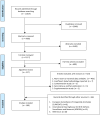
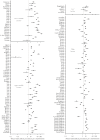
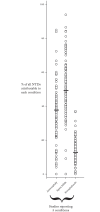

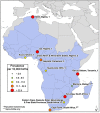


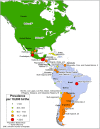

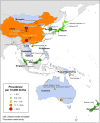

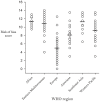

References
-
- Christianson AL, Howson CP, Modell B. Global report on birth defects: the hidden toll of dying and disabled children. White Plains (NY): March of Dimes Birth Defects Foundation; 2006.
-
- World Health Organization. Global health estimates (GHE)–Cause-specific mortality. 2015. Available:http://www.who.int/healthinfo/global_burden_disease/estimates/en/index1..... Accessed 2015 Apr 14.
-
- World Health Organization. Global health estimates (GHE)–Disease burden. 2015. Available: http://www.who.int/healthinfo/global_burden_disease/estimates/en/index2..... Accessed 2015 Apr 14.
-
- Rudan I, Chan KY, Zhang JS, Theodoratou E, Feng XL, Salomon JA, et al. Causes of deaths in children younger than 5 years in China in 2008. The Lancet. 2010; 375: 1083–1089. - PubMed
Publication types
MeSH terms
LinkOut - more resources
Full Text Sources
Other Literature Sources
Medical
Miscellaneous

